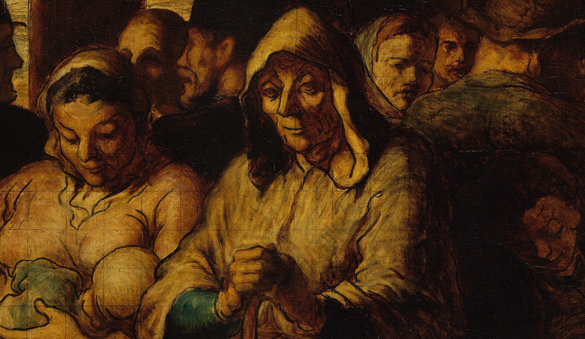RENDER Blog 15 – Rendering the True Working Class of the 19th Century
By: Jimena Martinez Gerhard
During the 19th century, France was the force in social revolution for unheard and marginalized groups. Artists fueled with the same spirits joined this fight by giving birth to realism. Honoré Daumier’s The Third Class Carriage (1865), which can be found at the National Gallery of Canada, reflects the class of people that wanted change.

The Third Class Carriage focuses on a mother, an old woman and a boy who seem strangers to each other, but they share in their look an exhaustion after a hard day’s work. Their social status is known. Their clothes reveal their simple lives and the reason why they are confined to the third-class carriage. The atmosphere is dirty with its hues of browns and yellows and the light is restricted by the confined space. Our eyes are guided through the carriage, but our attention is directed towards the people in it.
It is no surprise that Daumier would paint a subject like this one. He was known for his involvement in the political sphere in France. His satirical cartoons targeted the bourgeois and criticized the monarchy, especially Louis-Phillippe (famous for his depiction as a pear). During this time, the king favored people of the higher class such as merchants and factory owners while the lower-class workers demanded better conditions. Daumier, who also struggled with unemployment at some point of his life, sympathized with the working class and saw them as fellow passengers.
What is striking about this painting is Daumier’s willingness to depict the working class in their natural state, rather than demeaning or idealizing them. This realism is further achieved by the inclusion of the new working class. Industrialization and population growth brought a new economic reality to France. Many families in rural areas were forced to travel to find jobs. However, this was not enough. Women and children had to leave the household to bring economic support. Because of this new female independence, many women began having children out of wedlock. This was the basis of the new working class. In Daumier’s composition, the men are in the background while the women and children remain as the focus.
Daumier believed that art needed to have an intention. Third Class Carriage is a reminder for lower classes that they are not inferior to the bourgeois and that their work is being recognized. It also sets the scene for a social revolution that would bring justice for those who needed it the most.
About the Author: Jimena Martinez Gerhard is RENDER’s undergraduate blog contributor. This is her second year contributing to RENDER. Jimena is a third year undergraduate student at Carleton University completing a double major in Communication Studies and Art History. Born in Mexico, she also lived many years in Costa Rica before coming to Canada.